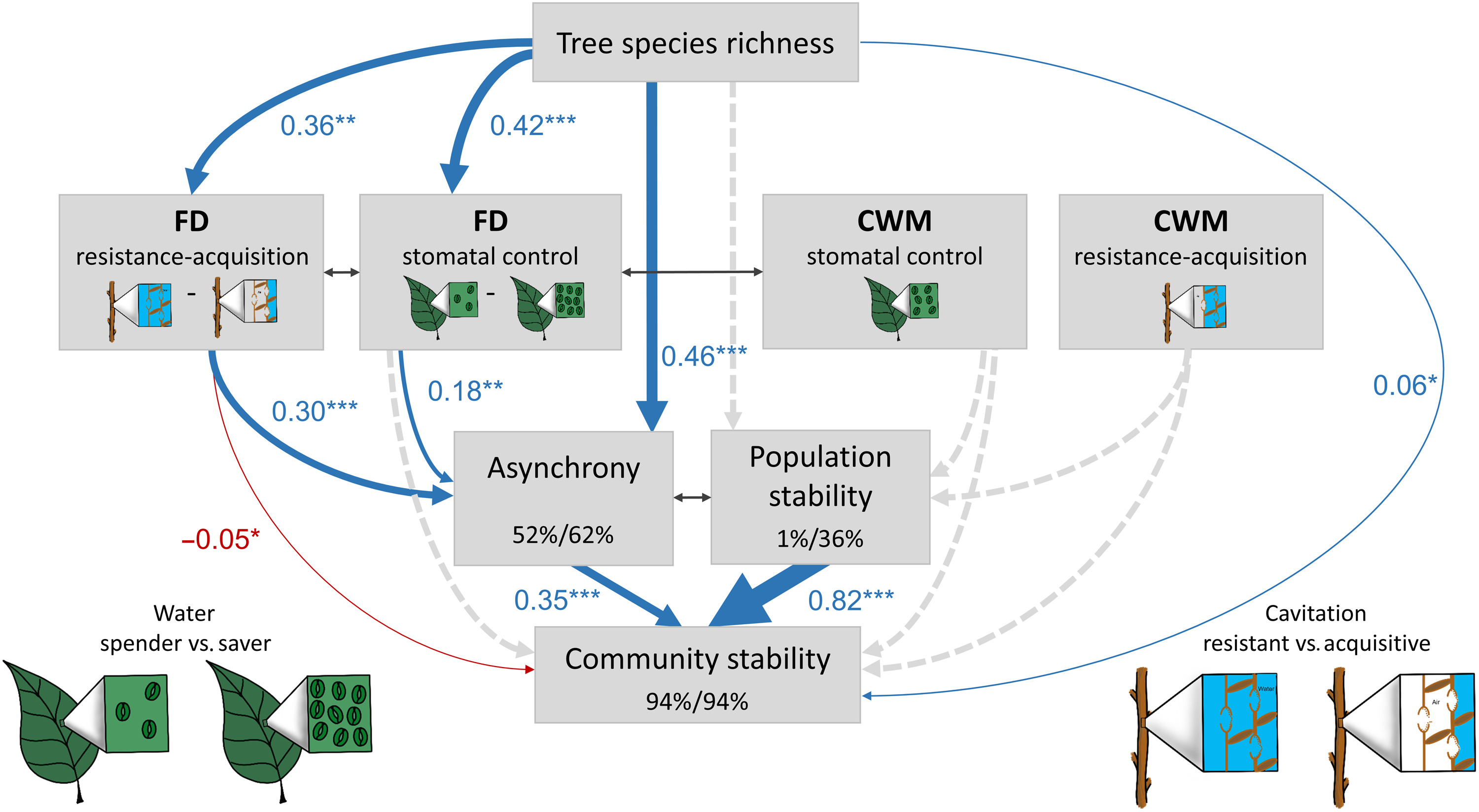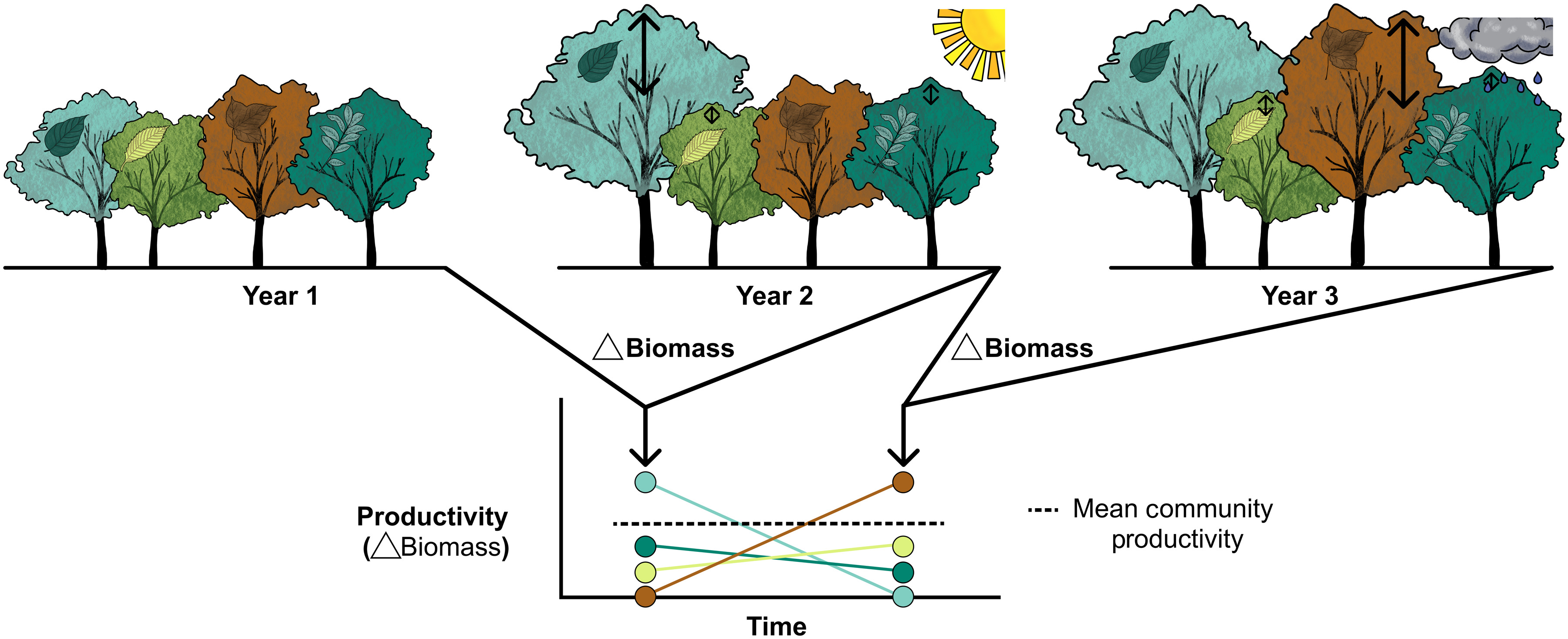Well insured: Forests with many tree species grow more consistently
Species richness stabilises forests against extreme climate conditions
Leipzig / Beijing. The annual growth of forests fluctuates due to extreme climate conditions such as drought and heavy rainfall. These fluctuations are less pronounced in species-rich forests than in those with low species richness. Furthermore, forests with many different tree species produce more wood. It is not only a question of the species’ richness, but also the diversity of their functional characteristics. This has been shown by an international research team led by the German Centre for Integrative Biodiversity Research (iDiv) and the Chinese Academy of Sciences Beijing (CAS). The results of the study have been published in the journal Science Advances. They provide significant impetus for ways in which forestry can promote more reliable productivity.
Forests around the world are under stress. Due to increased global warming, they have to adapt ever more rapidly to climatic fluctuations and the accompanying extreme events. This leads to reduced growth and die-back of trees, so that forests then not only absorb less carbon but, at the same time, emit more. This in turn drives climate change. Ecosystem services such as climate regulation, water storage and the provision of (building) materials then also decline.
An international research team has now investigated which factors influence the functioning of forests under climatic stress and how these interact. The team included members from iDiv, CAS, Leipzig University, Martin Luther University Halle-Wittenberg, TU Dresden Department of Forest Sciences, the University of Zurich and other institutions. They found that the forests which are best safeguarded against the effects of climatic stress are those that are species-rich. If some of the tree species in a forest grow less due to extreme weather conditions such as a year of heavy rainfall or drought, others can counterbalance this loss. This stabilises and ensures the productivity of the overall system.
Overall, species-rich forest stands provided a more stable biomass production than monocultures due to this protection against weather fluctuations. This means that annual timber growth varied less. “This connection between species richness and stable productivity, and their underlying mechanisms could so far only be shown in grassland experiments. We can now, for the first time, show this under experimental conditions for highly diverse subtropical forest ecosystems,” says lead author Florian Schnabel, scientist at iDiv and Leipzig University. “We were also able to show that species-rich stands were not only better safeguarded than monocultures, but also produced more wood,” says Schnabel. The doctoral researcher is a member of the TreeDì International Research Training Group TreeDi, which largely made the study possible.
The growth stability of the forests in the study was not only a result of the number of different tree species, but primarily of their differing functional characteristics. With regard to tree growth, for example, this can mean that one species grows well in a wet year and another in a dry one, a feature known as ‘asynchrony’. The diversity of species characteristics and the dynamics of the resulting reciprocal interactions between the species in, for example, the use of water, light and nutrients determine this asynchrony. This then affects the growth stability of the entire tree species community. The study showed that, in particular, drought tolerance, hydraulic conductance and evaporative capacity are important factors in tree growth stability. The more diverse a forest community’s characteristics, the more stable that community’s biomass production rate under fluctuating climatic conditions. The forest communities with the most stable growth were not those dominated by drought-tolerant species, but those distinguished by diverse drought-tolerance and water-use strategies.
The data on which the research results are based come from BEF-China, the world’s largest experiment for the study of forest biodiversity and the functioning of ecosystems. Another study recently carried out in BEF-China supports those results. Co-first author Dr. Xiaojuan Liu from CAS, who is also the senior author of this second study says: “Our study also showed that forests with a high richness of tree species with diverse functional characteristics achieve higher productivity than forests with a low diversity.”
Both studies highlight that growth stability and productivity in secondary and plantation forests can be improved by increasing the number of tree species. The studies provide important impetus for forest management strategies, and not only in subtropical areas. They encourage global forestry and initiatives for carbon offsetting to focus on planting, restoring and maintaining diverse, species-rich forests. This is key to maintain and increase forest growth stability and productivity in the face of climate change.
Senior author of the study, Prof Christian Wirth, is a research group leader at iDiv and Leipzig University as well as a fellow at the Max Planck Institute for Biogeochemistry. He emphasises the importance of the research result; “The world’s forests are more and more threatened by periods of drought. We therefore urgently need to protect their functioning. A crucial component for this is a change in our forest management, moving away from monocultures towards diverse mixtures, and the protection of natural mixed-species forests. This is the best insurance for the forests themselves, and, of course, also for their users.”

Figure2. Direct and indirect effects of tree species richness, drought-tolerance diversity, and CWMs of drought-tolerance traits on community stability.
Literature:
Original publication:
Florian Schnabel*†, Xiaojuan Liu*†, Matthias Kunz*, Kathryn E. Barry, Franca J. Bongers, Helge Bruelheide, Andreas Fichtner, Werner Härdtle, Shan Li, Claas-Thido Pfaff, Bernhard Schmid, Julia A. Schwarz, Zhiyao Tang, Bo Yang, Jürgen Bauhus, Goddert von Oheimb, Keping Ma and Christian Wirth. 2021. Species richness stabilizes productivity via asynchrony and drought-tolerance diversity in a large-scale tree biodiversity experiment. Science Advances. 7(51):eabk1643. https://doi.org/10.1126/sciadv.abk1643.
Second publication mentioned within the text:
Franca J. Bongers, Bernhard Schmid, Helge Bruelheide, Frans Bongers, Shan Li, Goddert von Oheimb, Yin Li, Anpeng Cheng, Keping Ma* and Xiaojuan Liu*. 2021. Functional diversity effects on productivity increase with age in a forest biodiversity experiment. Nature Ecology & Evolution. 5: 1594-1603. https://doi.org/10.1038/s41559-021-01564-3.
English report: https://www.idiv.de/en/news/news_single_view/2298.html
Chinese report: https://mp.weixin.qq.com/s/jbFpVDowmWZ6ZCuB3umlmA

